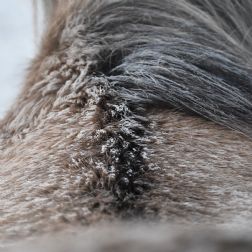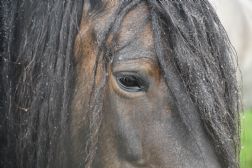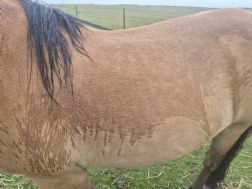10 years of Simple System HayCare!
During its 10 years so far, it has become apparent that HayCare is so much more than a hay replacer...

To rug, or not to rug? A question horse owners have been asking for many years! Here is some useful guidance to help you consider your horse's individual needs this winter.
Horses have two main lines of defence against the winter chill: one is a layer of fat accumulated during the summer and the other is a thick winter coat.
During the winter fat will (or should be) gradually used up. A layer of fat is like wearing an anorak! As the fat is used, the fat-soluble vitamins stored in it are also released. These are vitamins A, D, E and K.
The horse’s winter coat is an amazing bit of kit. There is a dense underlayer that is a really good insulator. Long, shiny guard hairs shed rain. Each hair has a tiny muscle attached which will fluff up the coat when it is cold to add even more insulation – just as birds fluff up their feathers to trap a layer of air in frosty weather.

Horses can thrive in very cold conditions. They evolved in the relatively dry, semi-desert conditions of the central Eurasian plateau. If it is windy, they turn their backs to the wind, clamp their tails to insulate their bottoms and the tail hairs spread out to shield their hindquarters. Horses act like weathervanes – they will always tell you where the wind is coming from! This winter coat is so good an insulator that snow and frost will remain on the horse’s back.

Rain can be tolerated well, albeit not so well if very prolonged, except for native breeds that have had long enough to adapt to our somewhat soggy winters. Eyes are protected due their shape and direction of the hair; thick manes take rainwater away from necks and shoulders; the guard hairs on the body direct rain to run off, keeping the belly dry; feathers on the fetlocks act like drain down-pipes, taking water away from the pasterns and heels. Waterproofing is taken care of with the natural grease in the undercoat.


Horses love to roll in the mud. A group will share the same mud patch, sharing their group identity as well as putting on a layer of earth that will act as an additional layer of insulation and keep the wind out of their coats. Grey horses seem to roll the most. Maybe it is good camouflage when a white coat is an obvious signal to a predator.

So is a rug neeeded? Probably not if your horse has a layer of fat and some natural shelter from the wind prevailing at the time. If your horse is worked and sweats excessively, you may feel moved to clip them. Remove only what is needed to make the horse comfortable. Depending on the horse, you may then need to use a rug, but if your horse is very fat, bear in mind that they are already wearing a good anorak!
We do not want our horses to suffer or get hypothermia, but being a bit chilly is not a disease. A cold but healthy horse will move around more, eat more (eating is heating) and keep close to their friends to share some mutual warmth. Interestingly, a horse that is not shivering in the field may start to shiver when tied up or stabled, just showing how effective movement is. Signs your horse may benefit from a rug include shivering, being hesitant to move, losing too much weight and reluctance to move away from shelter to graze or eat hay.
Losing weight over winter is natural and beneficial as it is thought to be protective against metabolic disease and the risk of laminitis. Mother Nature provides well for horses in the winter, so work with her for a happier horse and a happier you!
If you would like to discuss your horse's dietary needs, contact the Simple System Feed Line on 01728 604 008, or email info@simplesystem.co.uk
During its 10 years so far, it has become apparent that HayCare is so much more than a hay replacer...
Grass has the potential to grow all year, which is different from many other plants. Certain things are necessary for this growth, but if they are not met, the grass will be dormant, waiting for conditions to improve.Â
Rain fall can trigger growth akin to a spring flush, especially if temperatures are high. Even whilst true spring may be in the past, the risk for those prone to laminitis will rise.